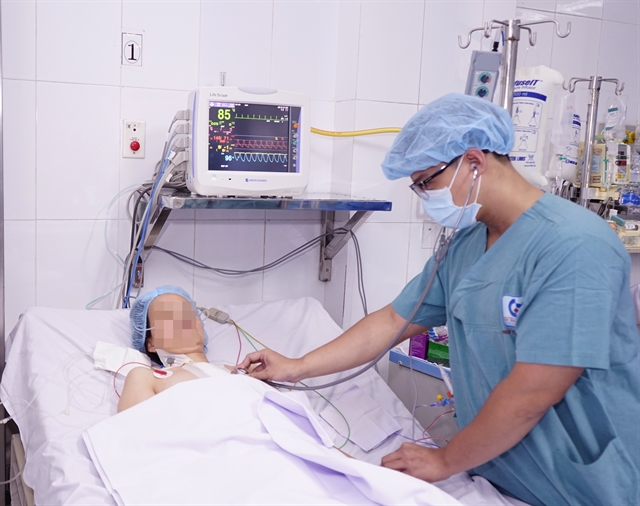 Society
Society


|
| A doctor at Gia Định People’s Hospital checks a patient who had an operation to remove a ruptured thoracic aortic aneurysm. Photo courtesy of the hospital |
HCM CITY— Several hospitals such as Gia Định People’s Hospital in HCM City have recently admitted more people aged 40-50 years with a thoracic aortic aneurysm, an enlargement in the upper part of the aorta, the major blood vessel that routes blood to the body.
Dr Bùi Minh Thành, head of the cardiac surgery department at Gia Định People’s Hospital, said: “Thoracic aortic aneurysm occurs most often in people aged 60-70 with atherosclerosis -- hardening of the arteries caused by a build-up of plaque in the inner lining of an artery -- and hypertension.”
People in their 50s and 60s could suffer from a thoracic aortic aneurysm due to infectious diseases such as syphilis and sepsis, Thành said.
“However, thoracic aortic aneurysms have been seen recently in people aged 40-50.”
On April 18, a 45-year-old woman from the city’s Bình Thạnh District was hospitalised at Gia Định People’s Hospital after a cardiovascular collapse due to a ruptured thoracic aortic aneurysm.
After admitting the patient, the hospital’s doctors immediately performed surgery to save her.
The hospital’s medical team of 11 took five hours to perform the surgery. During the surgery, the patient’s blood pressure dropped, which can be life-threatening.
The surgeons rapidly used resuscitation and set up a circulatory system outside her body to provide blood for the organs in her body. They removed the entire aneurysm and replaced it with a 12-cm artificial blood vessel, helping her heart beat again.
After five days in the hospital’s ICU, the patient has recovered and is expected to be discharged from the hospital later this week.
According to the Mayo Clinic in the US, most people with aortic aneurysms do not have symptoms unless a tear or rupture occurs. A dissection or a rupture is a medical emergency.
The Mayo Clinic advises that if people have a family history of aortic aneurysms, Marfan syndrome or another connective tissue disease, or bicuspid aortic valves, doctors may recommend regular ultrasounds or radiology testing such as CT scans or MRI exams to screen for aortic aneurysms.
Thành advised that people of any age with hypertension and pain in their chest should go to health facilities for periodic examinations so they can be treated in time if they have an aortic aneurysm or other life-threatening condition. VNS




